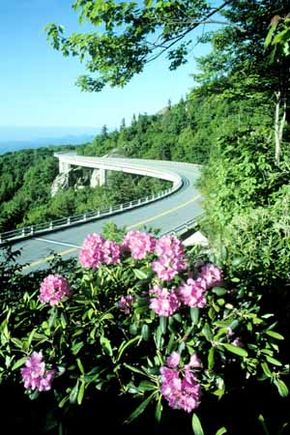North Carolina's Blue Ridge Parkway is a scenic drive that crests the southern Appalachian Mountains and takes you through a myriad of natural, cultural, and recreational places. Many people drive the Blue Ridge Parkway for its natural botanical qualities. And where there is lush vegetation, there is also abundant wildlife.
The diverse history and culture of the southern Appalachians are described at many overlooks and facilities along the parkway. Come see this remarkable panorama that's been eons in the making.
Advertisement
Archaeological Qualities of the Blue Ridge Parkway
You'll find many signs of Native American culture and influence along the Blue Ridge Parkway, including those of the Cherokee. Many of the fields still visible at the base of the mountains date back centuries to ancient Native American agricultural methods of burning and deadening the trees and underbrush to provide needed grazing and crop land. Mountain and river names along the parkway also reflect the Native American influence. In North Carolina, the parkway enters the Qualla Reservation. Remnants of early European settlements and homesteads are also found all along the parkway.
Cultural Qualities of the Blue Ridge Parkway
Along the Blue Ridge Parkway, evidence of the local cultures is found in communities, museums, and shops.
Mountain handicrafts are one of the most popular attractions along the byway, and traditional and contemporary crafts and music thrive in the Blue Ridge Mountains. Along the parkway in North Carolina are several places to view and purchase locally made items. The Folk Art Center in Asheville offers an impressive collection of crafts.
Historical Qualities of the Blue Ridge Parkway
The parkway was conceived as a link between the Shenandoah National Park in Virginia and the Great Smoky Mountains National Park in North Carolina and Tennessee. The vision came to fruition in 1935. The idea to build the parkway resulted from a combination of many factors, the primary one being the need to create jobs for those people suffering from the Great Depression and for poor mountain families.
World War II halted construction, but road-building resumed soon after the war ended. By 1968, the only task left was the completion of a seven-mile stretch around North Carolina's Grandfather Mountain. In order to preserve the fragile environment on the steep slopes of the mountain, the Linn Cove Viaduct, a 1,200-foot suspended section of the parkway, was designed and built.
Considered an engineering marvel, it represents one of the most successful fusions of road and landscape on the parkway. The Blue Ridge Parkway was officially dedicated in 1987, 52 years after the ground breaking.
Natural Qualities of the Blue Ridge Parkway
The creation of the Blue Ridge Mountains, perhaps hundreds of millions of years in the geologic past, was both violent and dramatic. Today, you can witness the flip side to the mountain-building story -- the mountain's gradual destruction. The slow, steady forces of wind, water, and chemical decomposition have reduced the Blue Ridge from Sierralike proportions to the low profile of the world's oldest mountain range.
Diversity is the key word when understanding the ecology of the Appalachian Mountains. Park biologists have identified 1,250 kinds of vascular plants, 25 of which are rare or endangered. The reasons for this wide diversity are numerous. Elevation is a key factor, with parkway lands as low as 650 feet above sea level and as high as 6,047 feet above sea level. The parkway is also oriented on a north-south axis, with its two ends far apart.
Beginning at the parkway's lowest elevations and climbing up to its highest, you notice numerous transitions among a variety of forest types. Interspersed among these various forest types are small habitats, such as mountain bogs and heath balds. Many species of animals find their niche in these small pockets of habitat. Bog turtles and Gray's lily thrive in mountain bogs.
Sheltered, wet coves are excellent for finding salamanders. A hemlock cove is a great place to find red squirrels. Black-capped chickadees replace the Carolina chickadees as you climb up toward the spruce-fir forest. And of course, the Blue Ridge Mountains are also home to mountain lions, eagles, and even bears. For birding enthusiasts, the parkway offers a never-ending supply of beautiful birds.
Recreational Qualities of the Blue Ridge Parkway
The very nature of the Blue Ridge Parkway allows for outstanding recreational opportunities, such as camping, hiking, cycling, swimming, and kayaking. Festivals and events are often occurring in local towns and communities, from sports to outdoor adventure to drama to folk art.
Find more useful information related to North Carolina's Blue Ridge Parkway:
- How to Drive Economically: Fuel economy is a major concern when you're on a driving trip. Learn how to get better gas mileage.
Advertisement

